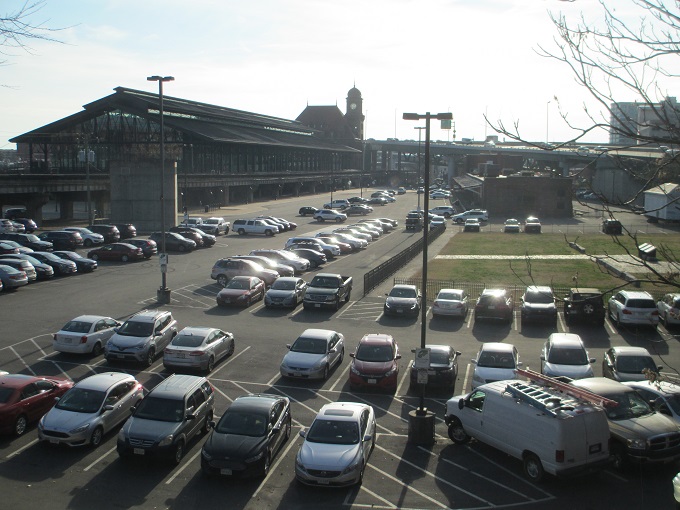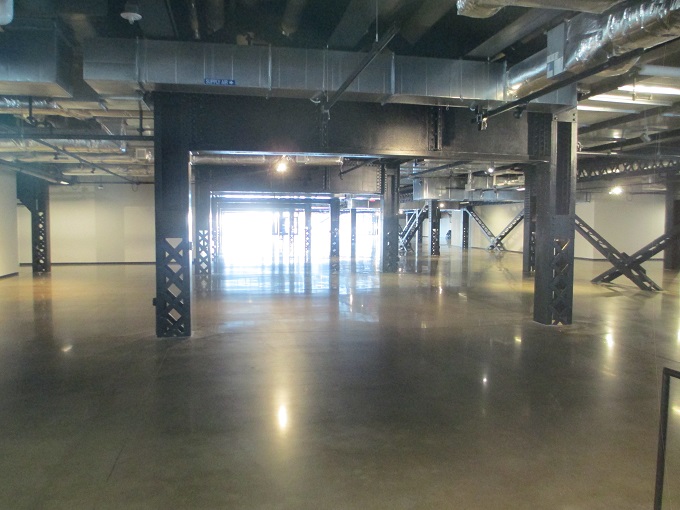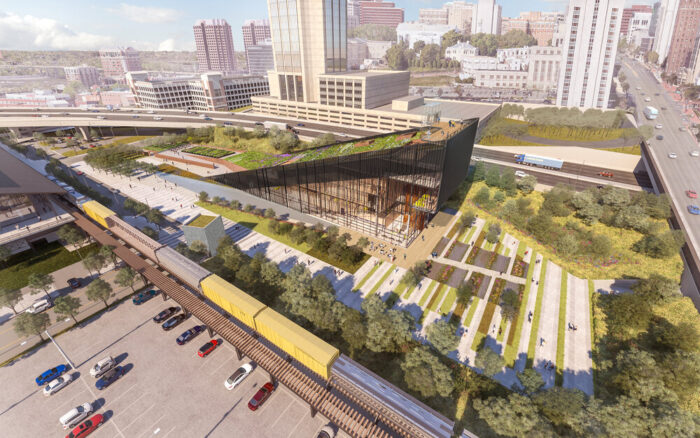
Main Street Station’s train shed is adjacent to sites that would form the Shockoe Bottom Heritage Campus, including the Lumpkin’s Jail/Devil’s Half Acre site visible to the right. (Jonathan Spiers photos)
Just days after removing its last standing Confederate monument, the City of Richmond has received a major funding boost toward its goal of creating a campus in Shockoe Bottom commemorating the area’s history as a slave-trade hub.
The city on Tuesday was awarded an $11 million grant from the Andrew W. Mellon Foundation for development and initial operations of an interpretive center at Main Street Station that would serve as a starting point for its planned Shockoe Bottom Heritage Campus.
The project is one of six Richmond-area efforts that received a total of $16 million in funding through the Mellon Foundation’s Monuments Project, launched in 2020 to award $250 million in grants for commemorative projects across the country that are providing a more complete picture of American history.
Other recipients include The JXN Project, which was awarded $1.5 million for its Skipwith-Roper Homecoming and JXN Haus project; The Valentine Museum, which received $1.2 million for various reinterpretation projects; and Cary Forward, a planned arts space and interpretive center that was awarded $1 million in November.
Rounding out the group is Untold RVA, which received $850,000 to research and develop walkable urban exploration routes; and Reclaiming the Monument, which was awarded $670,000 earlier this year to support its “Recontextualizing Richmond” public art project.
The city’s $11 million grant is the largest awarded through the Monuments Project so far. It was announced a week after the city removed its last Confederate monument, the A.P. Hill statue at Laburnum and Hermitage roads, wrapping up a two-year effort to remove Confederate iconography on city property.

The Shockoe interpretive center is planned to be located in this space at the north end of the train shed’s first floor.
The grant will fund an interpretive center in Main Street Station’s train shed that’s envisioned to serve as a gateway to the heritage campus. The center is planned to be located at the north end of the train shed’s first floor, adjacent to sites that would form the campus such as the Lumpkin’s Jail/Devil’s Half Acre site.
Also planned for the campus are a memorial park and a slavery museum that’s being developed by the privately led National Slavery Museum Foundation. While the museum is to be funded separately with state and philanthropic dollars, the grant award for the interpretive center adds momentum to the overall campus effort, said Jim Nolan, a spokesman for Mayor Levar Stoney’s office.
“Certainly an investment of the size announced today by a renowned and respected philanthropic organization demonstrates a commitment and confidence in the city’s overall vision for Shockoe that should encourage others to get involved and support its other key components, including a museum,” Nolan said in an email.
Through its five-year Capital Improvement Plan, the city has committed nearly $28 million in funding for the campus, which is projected to cost $38 million. It’s also allocated $10 million, of which $3 million has been spent, to assist with siting analysis and design for the museum and other campus-related projects. The state has also allocated $12.5 million for the museum and improvements to the Richmond Slave Trail.

A conceptual rendering of the slavery museum planned between the train tracks and the interstate. (File image courtesy of SmithGroup)
Utilizing the train shed as part of the heritage campus effort was one of several recommendations in the city’s draft Shockoe Small Area Plan. Released last year, the draft of the plan, which remains in development, called for exploring a temporary slavery museum space inside Main Street Station, among other suggestions tied to the heritage campus.
The heritage campus and park’s development is also one of six so-called “big moves” in the city’s Richmond 300 plan that are encouraged to be taken in the plan’s first five years.
Also recommended in the draft Shockoe plan were four “priority projects” to be implemented in the first 12 to 18 months. Those include hiring a cultural resource management firm to prepare an archaeology map and further research sites such as the African American Burial Ground; preparing a request for proposals to design the heritage campus and advance short-term projects; and implementing zoning recommendations.
According to an update this month on the city’s website, the city contracted with an unnamed consulting firm “to provide hydrologic and hydraulic modeling support to develop technical guidance for the Heritage Campus.” The work focuses on the area’s location in a floodway and aims to identify limitations to existing flood control infrastructure.
According to the Mellon Foundation’s announcement, the interpretive center at Main Street Station is planned to not only commemorate histories of the domestic slave trade, but also “of freed people, Virginia’s indigenous groups, Jewish communities, and other immigrant populations.”
The announcement included comments from Mellon Foundation President Elizabeth Alexander, who said Richmond “has been the site of many stories that have shaped our understanding of who we are as Americans, but public commemoration in Richmond historically has been limited to only a few.”
“Today, the people of this city are lifting up the collective memory of its historic Black communities, unflinchingly addressing the city’s past as the capital of the state with the most enslaved people prior to the Civil War, and participating in the reimagining of the city’s public spaces to better reflect the fullness of its history,” she said. “We are proud to support the remarkable grantees across the city leading this work.”
Years in the making, the heritage campus is planned to involve several city blocks on both sides of Broad Street east of the interstate. While the city controls some of that land, the sites also include land currently owned by the Loving family, whose properties generally east of the train shed have been targeted for the project.
Last year, the city made preparations to use eminent domain if needed to acquire those parcels, which as of this week remained in the family’s ownership.

Main Street Station’s train shed is adjacent to sites that would form the Shockoe Bottom Heritage Campus, including the Lumpkin’s Jail/Devil’s Half Acre site visible to the right. (Jonathan Spiers photos)
Just days after removing its last standing Confederate monument, the City of Richmond has received a major funding boost toward its goal of creating a campus in Shockoe Bottom commemorating the area’s history as a slave-trade hub.
The city on Tuesday was awarded an $11 million grant from the Andrew W. Mellon Foundation for development and initial operations of an interpretive center at Main Street Station that would serve as a starting point for its planned Shockoe Bottom Heritage Campus.
The project is one of six Richmond-area efforts that received a total of $16 million in funding through the Mellon Foundation’s Monuments Project, launched in 2020 to award $250 million in grants for commemorative projects across the country that are providing a more complete picture of American history.
Other recipients include The JXN Project, which was awarded $1.5 million for its Skipwith-Roper Homecoming and JXN Haus project; The Valentine Museum, which received $1.2 million for various reinterpretation projects; and Cary Forward, a planned arts space and interpretive center that was awarded $1 million in November.
Rounding out the group is Untold RVA, which received $850,000 to research and develop walkable urban exploration routes; and Reclaiming the Monument, which was awarded $670,000 earlier this year to support its “Recontextualizing Richmond” public art project.
The city’s $11 million grant is the largest awarded through the Monuments Project so far. It was announced a week after the city removed its last Confederate monument, the A.P. Hill statue at Laburnum and Hermitage roads, wrapping up a two-year effort to remove Confederate iconography on city property.

The Shockoe interpretive center is planned to be located in this space at the north end of the train shed’s first floor.
The grant will fund an interpretive center in Main Street Station’s train shed that’s envisioned to serve as a gateway to the heritage campus. The center is planned to be located at the north end of the train shed’s first floor, adjacent to sites that would form the campus such as the Lumpkin’s Jail/Devil’s Half Acre site.
Also planned for the campus are a memorial park and a slavery museum that’s being developed by the privately led National Slavery Museum Foundation. While the museum is to be funded separately with state and philanthropic dollars, the grant award for the interpretive center adds momentum to the overall campus effort, said Jim Nolan, a spokesman for Mayor Levar Stoney’s office.
“Certainly an investment of the size announced today by a renowned and respected philanthropic organization demonstrates a commitment and confidence in the city’s overall vision for Shockoe that should encourage others to get involved and support its other key components, including a museum,” Nolan said in an email.
Through its five-year Capital Improvement Plan, the city has committed nearly $28 million in funding for the campus, which is projected to cost $38 million. It’s also allocated $10 million, of which $3 million has been spent, to assist with siting analysis and design for the museum and other campus-related projects. The state has also allocated $12.5 million for the museum and improvements to the Richmond Slave Trail.

A conceptual rendering of the slavery museum planned between the train tracks and the interstate. (File image courtesy of SmithGroup)
Utilizing the train shed as part of the heritage campus effort was one of several recommendations in the city’s draft Shockoe Small Area Plan. Released last year, the draft of the plan, which remains in development, called for exploring a temporary slavery museum space inside Main Street Station, among other suggestions tied to the heritage campus.
The heritage campus and park’s development is also one of six so-called “big moves” in the city’s Richmond 300 plan that are encouraged to be taken in the plan’s first five years.
Also recommended in the draft Shockoe plan were four “priority projects” to be implemented in the first 12 to 18 months. Those include hiring a cultural resource management firm to prepare an archaeology map and further research sites such as the African American Burial Ground; preparing a request for proposals to design the heritage campus and advance short-term projects; and implementing zoning recommendations.
According to an update this month on the city’s website, the city contracted with an unnamed consulting firm “to provide hydrologic and hydraulic modeling support to develop technical guidance for the Heritage Campus.” The work focuses on the area’s location in a floodway and aims to identify limitations to existing flood control infrastructure.
According to the Mellon Foundation’s announcement, the interpretive center at Main Street Station is planned to not only commemorate histories of the domestic slave trade, but also “of freed people, Virginia’s indigenous groups, Jewish communities, and other immigrant populations.”
The announcement included comments from Mellon Foundation President Elizabeth Alexander, who said Richmond “has been the site of many stories that have shaped our understanding of who we are as Americans, but public commemoration in Richmond historically has been limited to only a few.”
“Today, the people of this city are lifting up the collective memory of its historic Black communities, unflinchingly addressing the city’s past as the capital of the state with the most enslaved people prior to the Civil War, and participating in the reimagining of the city’s public spaces to better reflect the fullness of its history,” she said. “We are proud to support the remarkable grantees across the city leading this work.”
Years in the making, the heritage campus is planned to involve several city blocks on both sides of Broad Street east of the interstate. While the city controls some of that land, the sites also include land currently owned by the Loving family, whose properties generally east of the train shed have been targeted for the project.
Last year, the city made preparations to use eminent domain if needed to acquire those parcels, which as of this week remained in the family’s ownership.
Wow, this is fantastic news. Well done, city leaders and visionaries! I love that this will be a prominent feature of Richmond as people drive through on I-95
Visionaries for a needed museum planned since (and funded) since the last days of McDonnell administration that will go in the basement of the train station for $11M. And the current numbers do not seem to add up but even $38M is not going to be enough to build the planned permanent museum. It has been discussed that the final cost will be around $220M (and that is 2021 costs). This is all about politics so the Lt Gov candidate-to-be Stoney can add to his “accomplishments” for his run of up the political ladder. Richmond Defenders for Freedom, Justice and… Read more »
Dear City Council: Thank you so much for decimating Monument Avenue! While I welcome a Slavery Museum, it should have been in addition to our monuments. That Jefferson Davis opposed secession, or that Robert E. Lee opposed slavery has been lost to your desire to virtue signal. News flash: the Soldiers and Sailors’ monument that was in Libbie Hill Park was dedicated to (wait for it) . . . soldiers and sailors! Seventy-five percent of these brave soldiers did not own slaves; all of them died protecting their homes and loved ones from an invading army, an invasion which was… Read more »
Once a traitor, always a traitor. The statues went up against the wishes of Robert E Lee, and now they’ve come down with the support of Lee’s relatives. Even more importantly, the residents of the city did not want the monuments any more. I grew up loving the Avenue itself, but what I loved was the magnificent homes and its grand scale (wide median and roomy sidewalks). Let’s celebrate the street for what it is today and not what it was. I’m glad we’ve finally torn down the participation trophies and most of all I’m proud to be an American,… Read more »
3 reasons to remove Confederate general monuments:
1) Confederate generals were traitors against the USA
2) Confederate generals fought to defend slavery
3) Confederate generals lost
News flash: need 3 more? (wait of it)…
4) The Confederacy started the war by seceding from the USA (treason, anyone?)
5) Individual municipalities have local autonomy to decide these issues
6) Disenfranchisement and oppression of African-Americans did not end with the conclusion of the civil war. Confederate statues were an ongoing visual symbol of Jim Crow as much as they honored the generals.
We shall overcome
Number 4 is not exactly true. The Confederacy started the war by attacking a US Federal Fort. Secession was not clearly not allowed — there was even widespread thinking that it was allowed. This happens in civics all the time — a government says something will be revokeable or temporary — and then years later the government says “nevermind what they said then, this is what we are saying now” —- it is why Jefferson Davis was never put on trial, but held guantanomo like for I think two years in a damp cell until he got very sick and… Read more »
interpretive center….sigh…
Yep some signs and art in the basement section of an underused train station who entrance is only accessible out the back of an often hard to navigate and poorly maintained parking lot. Hey at least Stoney will have another line on his political bio….”laid the cornerstones for the Richmond Slavery Museum.” Sigh is right Kay…all talk minimal action. I don’t even think the City has finalized the move for the poor Winfree cottage yet.